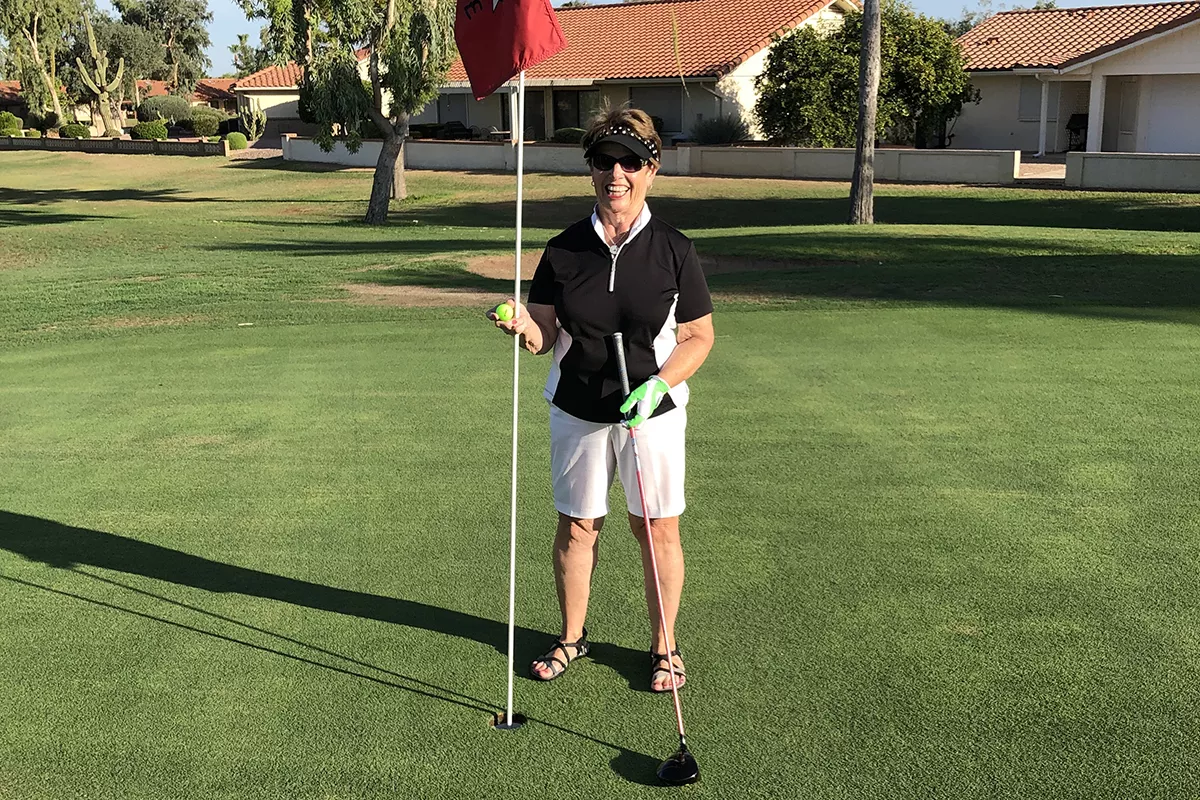Pat sinks a hole-in-one after reverse shoulder replacement

Pat Knebel of Iowa City loves to play golf with her husband, Ben. But sharp pains in her shoulder were putting a crimp in her swing.
For nearly four years, she tried pain relievers, gel products, and steroid injections. Nothing helped.
Then she visited University of Iowa Health Care orthopedic surgeon Brendan Patterson, MD, who recommended reverse total shoulder arthroplasty, an increasingly popular type of shoulder replacement that helps people like Pat get back to a normal life.
Within four months of her surgery, Pat was pain-free and swinging her clubs again. Eight months later, she made a hole-in-one.
Rotator cuff damage rules out standard shoulder replacement
As Pat’s shoulder pain got worse, the effects went way beyond her golf game. Even the simplest tasks became difficult and unpleasant.
“Opening a jar was tricky,” Pat says. “Other movements were painful, too, like stirring with my right hand. The pain made it hard to get a good night’s sleep. It was hard to dress. I couldn’t even put my arm through a sleeve.”
Patterson examined Pat’s shoulder and found that she had significant arthritis and a torn rotator cuff. The rotator cuff is the group of muscles and tendons that help to stabilize the shoulder joint and guide the shoulder’s movements.
Without a properly functioning rotator cuff, Pat wasn’t a candidate for a standard shoulder replacement, because a standard artificial shoulder joint requires a well-functioning rotator cuff, just like a natural shoulder joint does.
Patterson recommended a procedure called reverse total shoulder arthroplasty—a shoulder replacement that reverses the anatomy of the shoulder so that the joint is less reliant on the rotator cuff for movement.
Reverse positioning offers alternate approach to eliminating shoulder pain
In a standard shoulder replacement surgery, the damaged ball and socket joint is replaced with artificial parts. The ball at the top of the upper arm bone is replaced with a metal ball, and the diseased socket in the shoulder blade is replaced with a socket made from durable plastic liner that allows the ball to glide smoothly inside of it.
In a reverse shoulder replacement, the positions of the ball and socket are switched. The new ball is attached to the shoulder blade, and the new socket is attached to the upper arm.
“This reverse positioning makes it possible for the large muscle on the side of the shoulder, the deltoid muscle, to power and lift the arm instead of the damaged rotator cuff,” Patterson says.
Pat was skeptical, but she also knew nothing else had worked for her.
“I hadn’t heard about reverse shoulder replacement,” she says. “I didn’t like the idea of surgery and worried about my ability to swing a golf club again. But the pain was getting worse.”
UI shoulder replacement research improves outcomes for patients
Patterson takes skepticism like Pat’s very seriously.
In addition to his duties as a surgeon, he is actively involved in scientific research of shoulder replacement, including studying the outcomes of reverse shoulder replacement and how to improve the procedure, which surgeons began using in the United States in 2004.
Working with Don Anderson, PhD, and Joshua Johnson, PhD, in the UI Orthopedic Biomechanics Laboratory, Patterson has developed a computer modeling program to better understand the best position of shoulder replacement parts during surgery.
After reverse shoulder replacement many people remain active and enjoy activities with less pain and more function than they have had in years.
“Increasingly, data shows that patients do very well after reverse shoulder replacement,” Patterson says. “And with the evolution of new implants and techniques, we see significant improvements in range of motion as well.”
In his own practice, Patterson has seen for himself how quickly many patients return to their normal activities, without extensive physical therapy.
“Reverse shoulder replacement has one of the fastest recoveries of any shoulder surgery we do,” Patterson says. “Afterward, patients wear a special sling for four weeks to keep the shoulder immobilized. When the sling comes off, they start their own home exercise program without the need for extensive physical therapy.”
After three months, Patterson says, most patients can get back to using the shoulder for many of their activities without the need for structured formal physical therapy.
Putting the new shoulder to the test on the golf course
Patterson performed Pat’s reverse shoulder replacement in 2018, and her recovery was swift.
“I spent one night in the hospital and didn’t feel any pain afterward,” she says. “At home, I took only one dose of medication.”
Less than four months later, Pat’s swing was back, and eight months after that she recorded the first hole-in-one of her life. She says the shot was the result of more than just good luck.
“In a way,” Pat says, “I thank Dr. Patterson for my hole-in-one!”
Two years after surgery, she still never feels pain in the shoulder.
“It’s freed me up to do the things I want,” Pat says. “It’s been wonderful.”